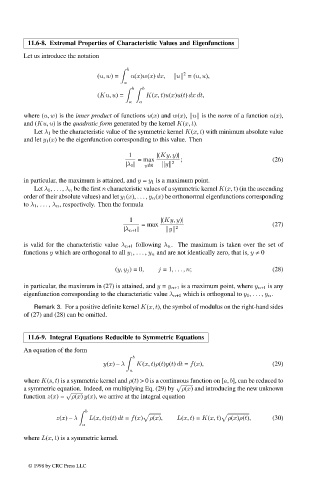Page 561 - Handbook Of Integral Equations
P. 561
11.6-8. Extremal Properties of Characteristic Values and Eigenfunctions
Let us introduce the notation
b
2
(u, w)= u(x)w(x) dx, u =(u, u),
a
b b
(Ku, u)= K(x, t)u(x)u(t) dx dt,
a a
where (u, w) is the inner product of functions u(x) and w(x), u is the norm of a function u(x),
and (Ku, u)isthe quadratic form generated by the kernel K(x, t).
Let λ 1 be the characteristic value of the symmetric kernel K(x, t) with minimum absolute value
and let y 1 (x) be the eigenfunction corresponding to this value. Then
1 |(Ky, y)|
|λ 1 | = max y 2 ; (26)
y /≡0
in particular, the maximum is attained, and y = y 1 is a maximum point.
Let λ 1 , ... , λ n be the first n characteristic values of a symmetric kernel K(x, t) (in the ascending
order of their absolute values) and let y 1 (x), ... , y n (x) be orthonormal eigenfunctions corresponding
to λ 1 , ... , λ n , respectively. Then the formula
1 |(Ky, y)|
|λ n+1 | = max y 2 (27)
is valid for the characteristic value λ n+1 following λ n . The maximum is taken over the set of
functions y which are orthogonal to all y 1 , ... , y n and are not identically zero, that is, y ≠ 0
(y, y j )=0, j =1, ... , n; (28)
in particular, the maximum in (27) is attained, and y = y n+1 is a maximum point, where y n+1 is any
eigenfunction corresponding to the characteristic value λ n+1 which is orthogonal to y 1 , ... , y n .
Remark 3. For a positive definite kernel K(x, t), the symbol of modulus on the right-hand sides
of (27) and (28) can be omitted.
11.6-9. Integral Equations Reducible to Symmetric Equations
An equation of the form
b
y(x) – λ K(x, t)ρ(t)y(t) dt = f(x), (29)
a
where K(s, t) is a symmetric kernel and ρ(t) > 0 is a continuous function on [a, b], can be reduced to
√
a symmetric equation. Indeed, on multiplying Eq. (29) by ρ(x) and introducing the new unknown
√
function z(x)= ρ(x) y(x), we arrive at the integral equation
b
z(x) – λ L(x, t)z(t) dt = f(x) ρ(x), L(x, t)= K(x, t) ρ(x)ρ(t), (30)
a
where L(x, t) is a symmetric kernel.
© 1998 by CRC Press LLC
© 1998 by CRC Press LLC
Page 544

